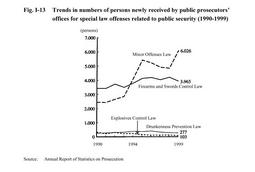| Previous Next Index Image Index Year Selection | |
|
|
2 Public security Fig. I-13 shows trends in the number of persons newly received by public prosecutors'offices for special law offenses related to public security over the last ten years.
The number for Firearms and Swords Control Law violations bottomed at 3,420 in 1991, after which it was in a generally increasing trend. However, in 1999 the number was 3,965, falling below 4,000 for the first time in 5 years. As for Minor Offense Law violations, meanwhile, the number had fallen since 1996, but in 1999 it topped the previous year's figure by more than 1,000 to reach its highest point in the ten-year period. The number for Explosives Control Law violations is generally in a declining trend, being on a par at around 100 since 1995, while the number for Drunkenness Prevention Law violations has fluctuated between around 200 and 300 since 1990. According to Criminal Statistics by the National Police Agency, viewing the number of persons cleared for special law offenses related to public security in 1999 by the nature of the violation, the most common amongst Firearms and Swords Control Law violations was carrying a knife, followed by aggravated possession of a pistol or similar, illegal possession of a pistol or similar, illegal possession of swords and firearms other than pistols and hunting rifles, and carrying an imitation sword, in that order. The most common Minor Offense Law related violations were removal of bills or markers, followed by carrying an offensive weapon, voyeurism, and trespassing on crop fields or similar, in that order. The most common Explosives Control Law related violations were possession, followed by conveyance and use, in that order. Fig. I-13 Trends in numbers of persons newly received by public prosecutors'offices for special law offenses related to public security (1990-1999) |
